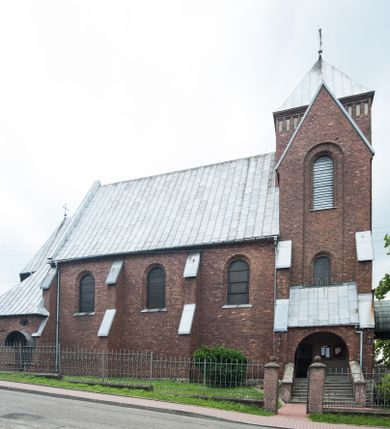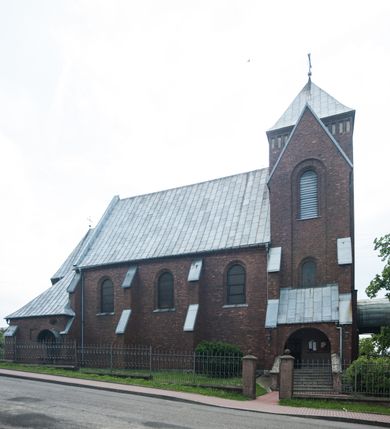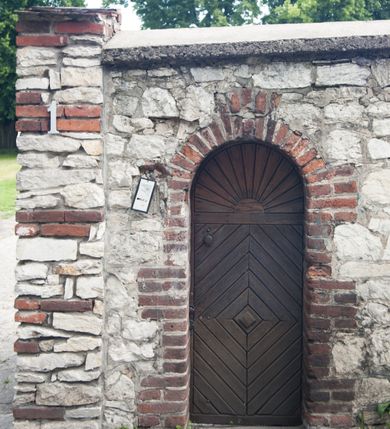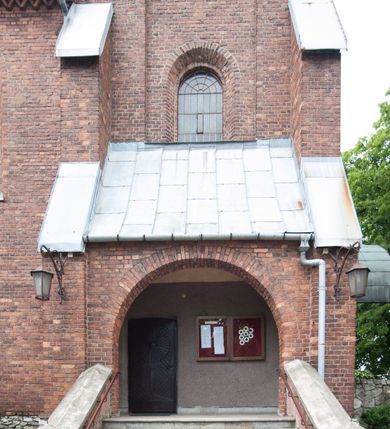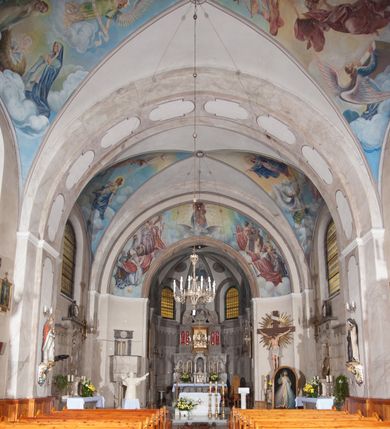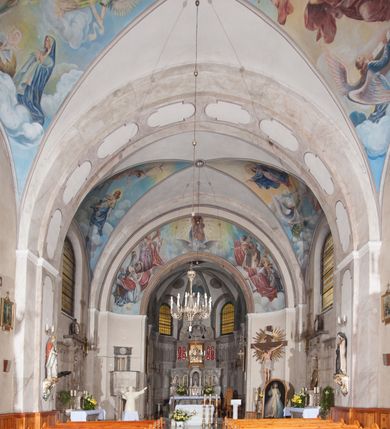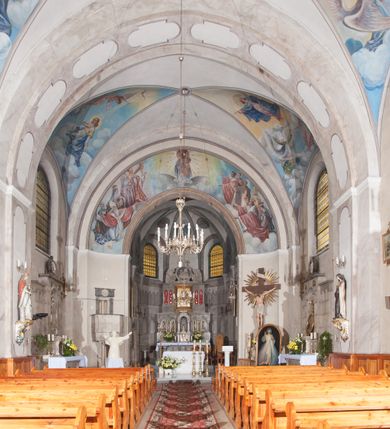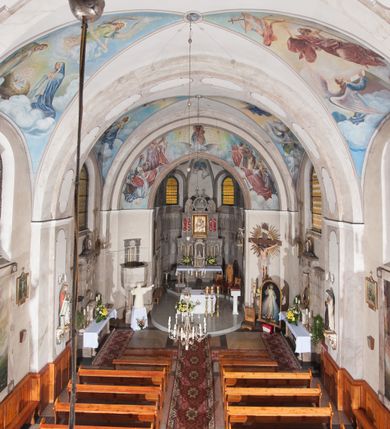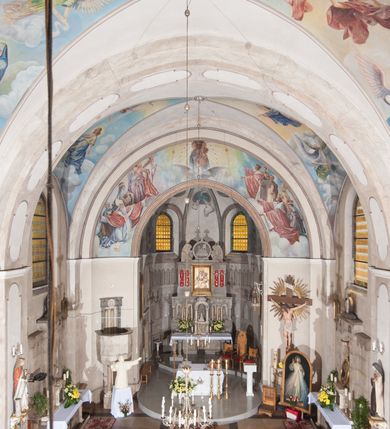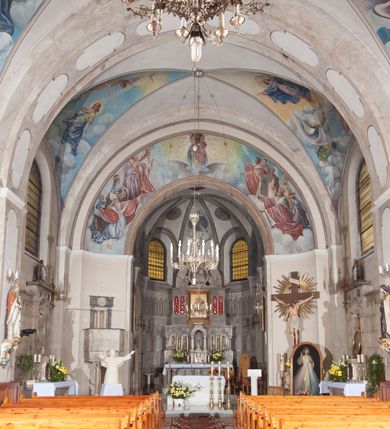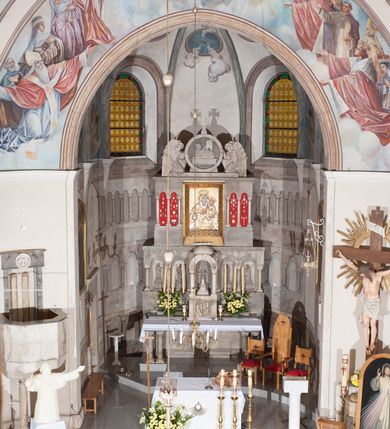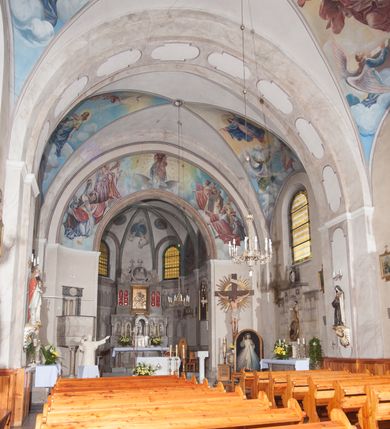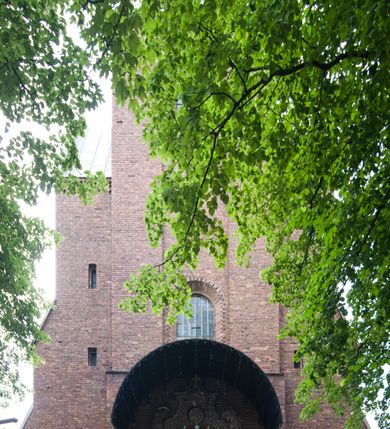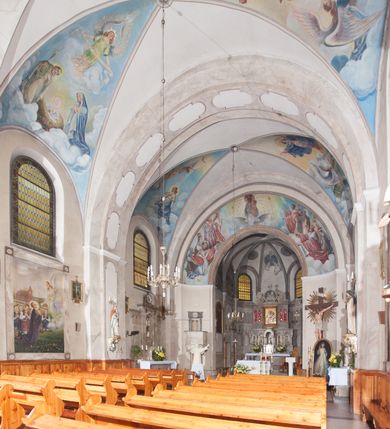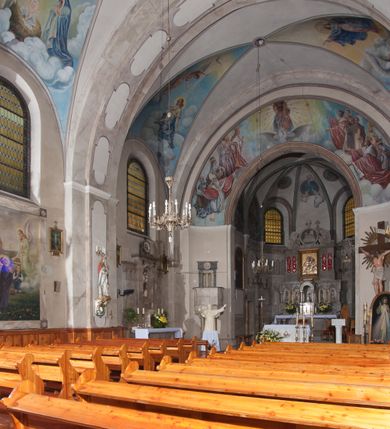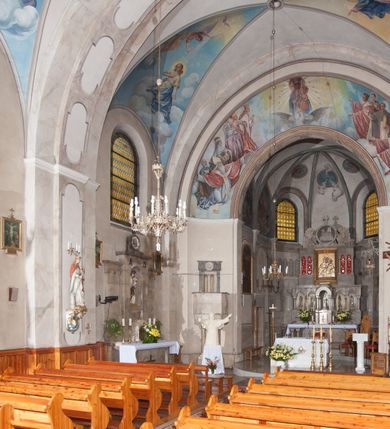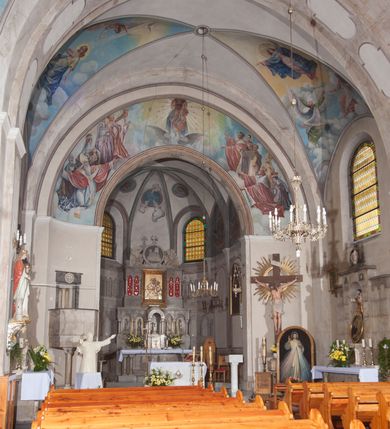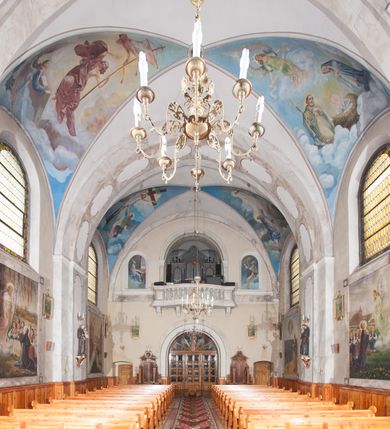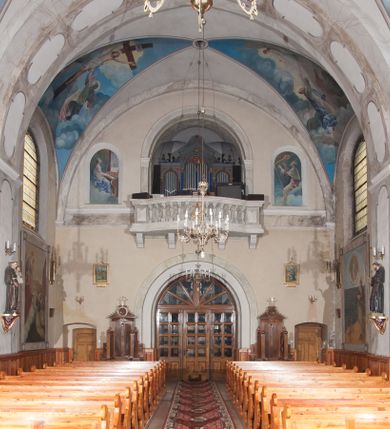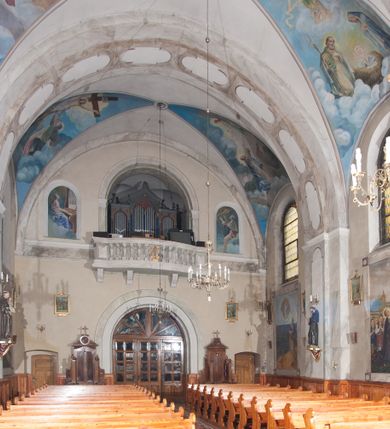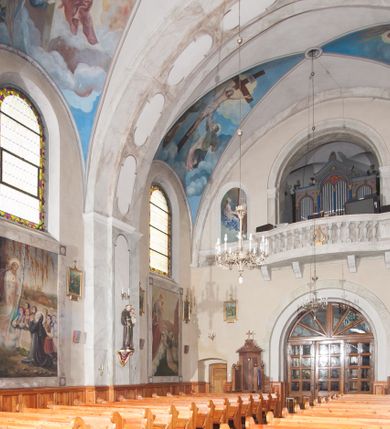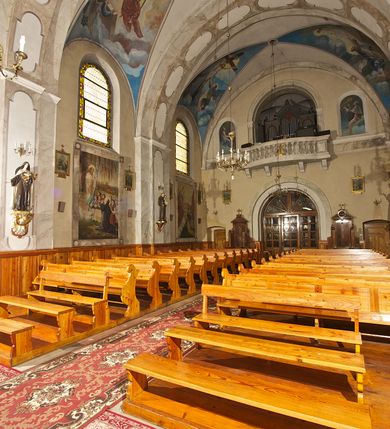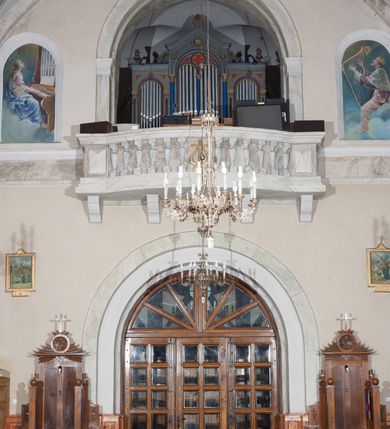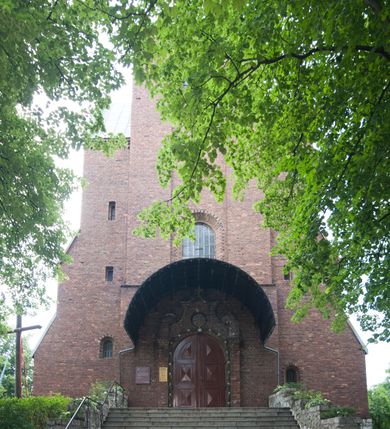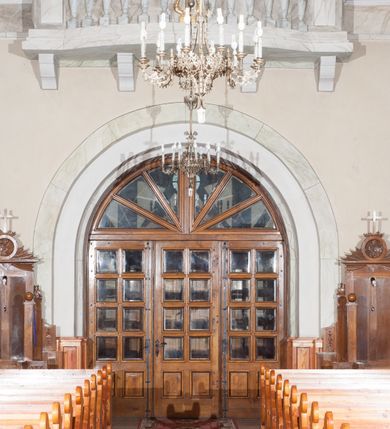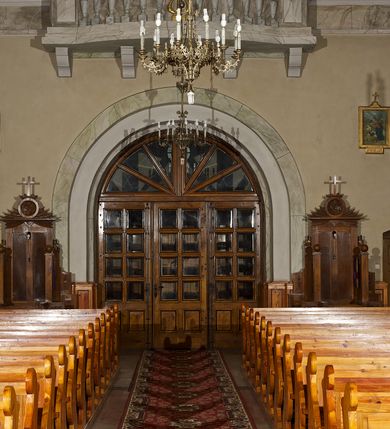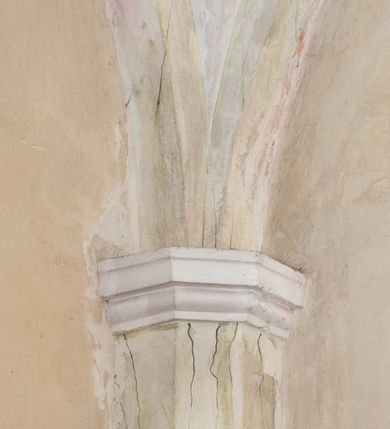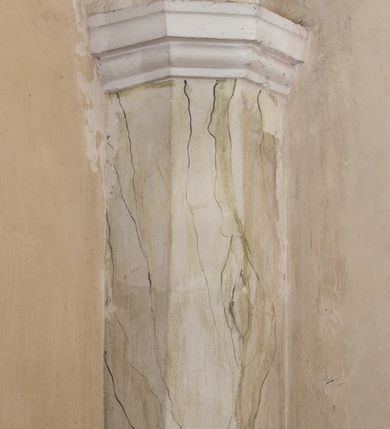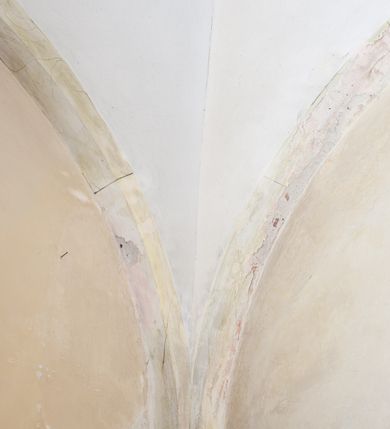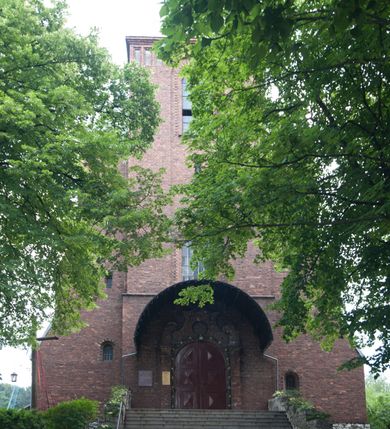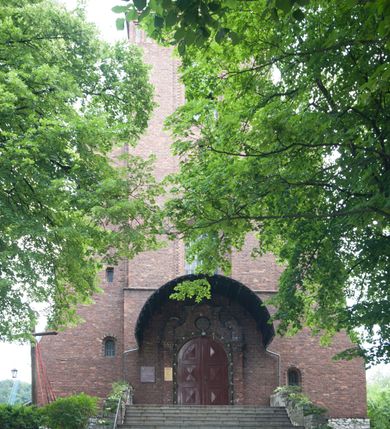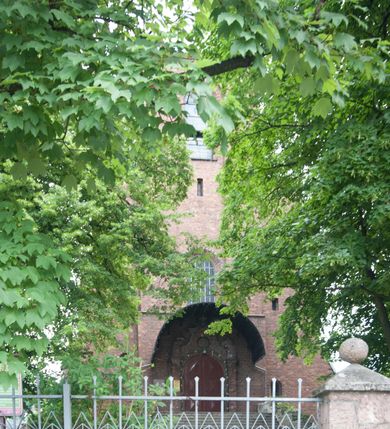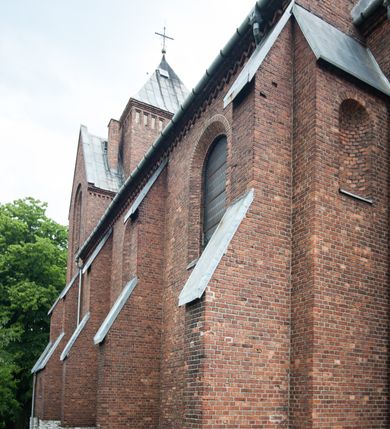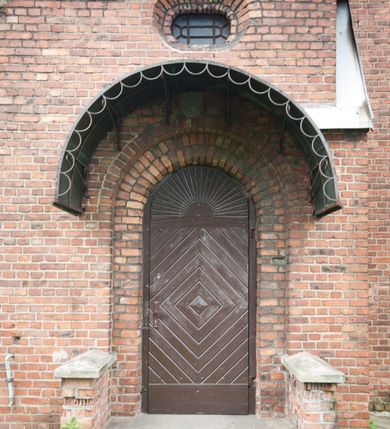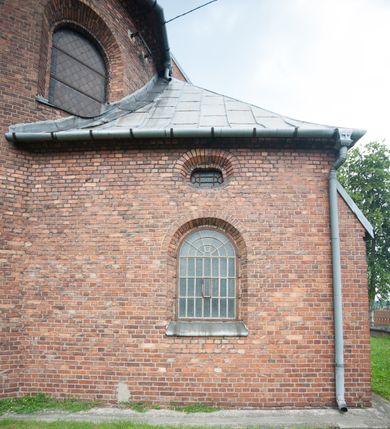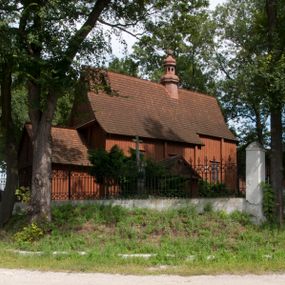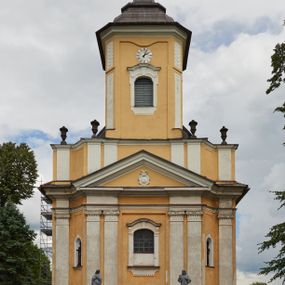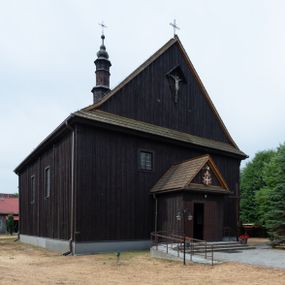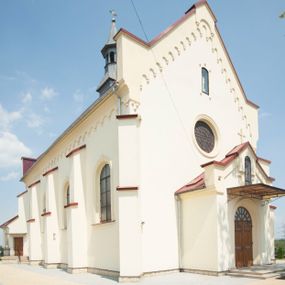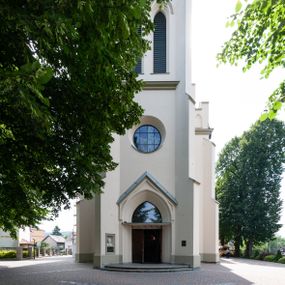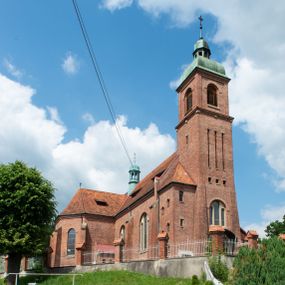
Church of Our Lady of Protection
Identifier
DZIELO/12521
Catalogue note author
Justyna Kuska
History of work
The parish in Kamień was founded by cardinal Jan Puzyna on March 15, 1909, and the ministry there was entrusted to the Cracovian Convention of Canons Regular of the Lateran, who had been the owners of the village since 1408. Before the current temple was built, a wooden chapel from the end of the 18th century served as a parish church, but small size did not meet the needs of the local community. The problem of lack of space in the chapel was not really solved by adding a wooden porch to the western elevation, which slightly increased the cubic capacity of the temporary church. In this situation, the idea of building a new, bigger construction emerged. Its plans were developed in 1914 by an architect from Warsaw, Zdzisław Mączeński. Unfortunately, the outbreak of the First World War prevented the commencement of construction works. The temporary chapel was used as a parish church until November 1923 when the then parish priest Jan Dominik Widerski, after obtaining permission from Bishop Sapieha, decided to dismantle the chapel. He planned to start building a new wooden temple immediately and thus withdaw from the implementation of the pre-war project by Mączeński as being "too expensive and time-consuming". However, it did not happen. Because of a conflict with the convention of canons regular, Father Widerski was forced to abandon his idea and leave Kamień, which happened on 10th March 1924. A refectory located on the first floor of a monastery house erected before the First World War was another temporary place of worship. Its chapel was arranged with the consent of Bishop Sapieha. The present brick parish church was built as late as in 1924-1928. Father Józef Dróżdż became the new parish priest and builder of the temple. The cornerstone of the future temple was laid by Archbishop Sapieha during his visit to Kamień on 20th June 1924. During the works, the pre-war project by Mączeński was used, modified by the architect Józef Kryłowski from Podgórze and the builder Ludwik Struzik. The construction was completed in 1927 in spite of financial problems and shortage of materials. On 15 July 1928, the church was solemnly consecrated by the suffragan bishop Stanislaw Rospond. Initially, the furnishings of the temple were made of wooden altars from the chapel demolished in the 1920s. In the main altar, there was a painting of Our Lady and the Child from the turn of the 17th century, which enjoyed a local cult. The side altars were dedicated to the Sacred Heart of Jesus and St. Anthony of Padua. A wooden baptismal font and a pulpit as well as paintings depicting the Dormition of the Blessed Virgin Mary and the Funeral of the Virgin Mary also came from the furnishings of the former chapel. In the 1930s, the church obtained new pews made of larch wood, choir-stalls in the chancel (removed in 1968) and confessionals. In 1937-1939, works on the construction of new altars were carried out. It was initially considered to have them made of wood by a team of carpenters working in the monastery workshop headed by the sculptor Wojciech Maciejowski. Eventually, however, the altars were built of alabaster with its characteristic grey colour, and their construction was carried out by "Żórawno" Alabaster Factory from Żórawno upon Dniester (currently in the territory of Ukraine). The side altars feature statues of St. Joseph and of the Sacred Heart of Jesus. Initially, the carved statue of the Mother of God was to be placed in the main altar but the parishioners were reluctant to that idea so the above-mentioned painting of the Mother of God with the Child was placed in the new reredos. Also a new pulpit and baptismal font, as well as a balustrade separating the presbytery from the nave (removed in 1979) - all elements made of alabaster - were ordered in the factory in Żórawno. Further changes in the firnishings of the temple in Kamień took place already during the Second World War. In 1940, a silvered dress made in Krakow was added to the painting of Our Lady in the main altar. In 1939, a polychrome showing scenes from the life of Mary and Christ was was created by Ludwik Konarzewski and his disciple Jan Molga. Professor Konarzewski also painted three table paintings for Kamień temple, depicting the Baptism of Christ, the Multiplication of Loaves and the Last Supper, while Jan Molga created the paintings depicting the Meditations of St. Augustine, the Vision of Blessed Stanislaw Kazimierczyk, the Vision of St. Margaret Alacoque and the Communion of Stanislaw Kostka. Other works that were placed in the temple before 1944 include sculptures of Christ Crucified, Pieta and Resurrected Christ by Wojciech Maciejowski and figures of saints: Thérèse of Lisieux (also chiseled by Maciejowski), Barbara, Francis of Assisi and Anthony of Padua (by Maciejowski's disciples). In 1942, additional confessionals and pews were purchased and the floor was laid, while in 1943-1944 work on the stained-glass windows were carried out according to the project by Ludwik Konarzewski (made by Tadeusz Wilkosz in Krakow). The church, especially the newly restored stained-glass windows, suffered from the bombardment of the village on 13 September 1944. The damage was so severe that the continued operation of the temple was threatened. Although the dismantling of the church was considered, it was decided to gradually repair the damaged building. In 1946, a new bell cast in the Felczyński factory in Przemyśl was purchased. It replaced an older instrument still from the wooden chapel, which was confiscated by the Germans in 1941. In the second half of the 1950s, the temple was expanded by an organ, which replaced the previously used harmonium. In 1958, its construction was completed, but the instrument was defective, and therefore, it was recommended that it be repaired. The issue was finalised in 1964. The post-war years were also a time of efforts to obtain new stained glass windows. In may 1947, the first two compositions made in the workshop of Tadeusz Wilkosz in Cracow were inserted, in 1956 the next two stained glass windows were purchased and in 1960 one more. The remaining three compositions were made in 1968-1969 in Cracow (unfortunately, it is not known in which workshop). Subsequent changes in the decoration of the temple in Kamień were connected with the implementation of changes resulting from the reforms of the Second Vatican Council - in 1971 a new altar of celebration was erected facing the faithful and the rood screen. The area by the church was surrounded by a fence in the 1970s. At the end of the decade, on the initiative of parish priest Tadeusz Masłowski, changes were also made to the polychrome. Painter Jerzy Witkowski only left figural scenes from the polychrome by Ludwik Konarzewski, replacing the floral ornament with paintings imitating architectural motifs taken from decorations of alabaster altars. The newest elements of the furnishing of the church in Kamień include the new altar of celebration and rood screen made of Carrara marble as well as the granite floor made in the stonemasonry company in Rusocice in 2008.
Abstract
The parish church in Kamień is a building of modest size, whose architecture combines various stylish features, mainly neo-gothic with neo-baroque elements. The parish in Kamień was founded by cardinal Jan Puzyna on March 15, 1909, and the ministry there was entrusted to the Cracovian Convention of Canons Regular of the Lateran, who had been the owners of the village since 1408. Before the current temple was built, a wooden chapel from the end of the 18th century served as a parish church, but small size did not meet the needs of the local community. The chapel was demolished in November 1923. The current stone parish church was built in 1924-1928 according to the design of the Warsaw architect Zdzisław Mączeński from 1914, which was significantly modified by the architect Józef Kryłowski and the builder Ludwik Struzik. As a result of the modification, the church building was reduced, the construction of side chapels as a reduced transept, planned by architect, were abandoned, and the enlarged tower with a neo-baroque tented roof was reduced to the form of a facade wall turning into a massive four-sided form covered with a simple, pyramidal roof. Changes introduced by Kryłowski and Struzik blurred the eclectic character of Mączeński's concept, giving the temple in Kamień much more barren and heavier character. In turn, the furnishings of the Church of Our Lady of Protection in Kamień are a collection of works of art from various eras, the vast majority of which are objects from the first half of the 20th century. A valuable set of alabaster altars, a baptismal font and a pulpit with neo-Roman features (made in the late 1930s in the "Żórawno" Alabaster Factory in Żórawno belonging to the Czartoryski family) deserve particular attention. Valuable objects also include sculptures made in the early 1940s by the Cracovian sculptor Wojciech Maciejowski and his students, and preserved fragments of figural polychrome from 1939-1940, painted by professor Ludwik Konarzewski and his students.
Other works from this place
Other works from this year
Similar works
By title
By category
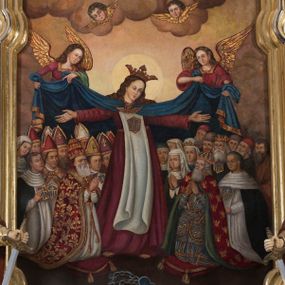
Our Lady of the Redemption of Slaves
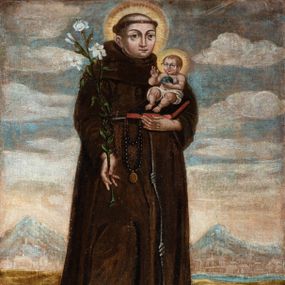
St. Anthony of Padua
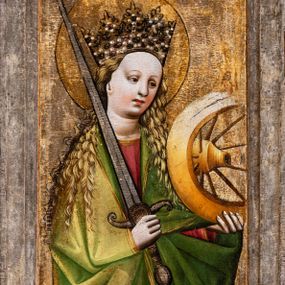
A front left wing of the old triptych of Our Lady of the Immaculate Conception
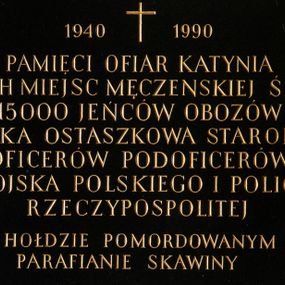
A plaque commemorating the victims of extermination
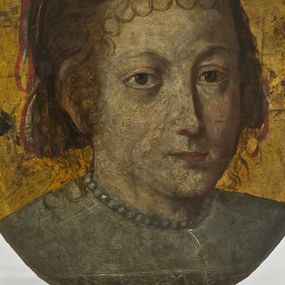
A portrait of Zofia Kochańska of the Swierczewski family
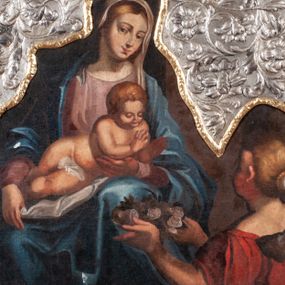
Adoration of Mary
How to cite?
Justyna Kuska, "Church of Our Lady of Protection", [in:] "The Sacred Lesser Poland Heritage", 2026, source: https://sdm.upjp2.edu.pl/en/works/church-of-our-lady-of-protection
